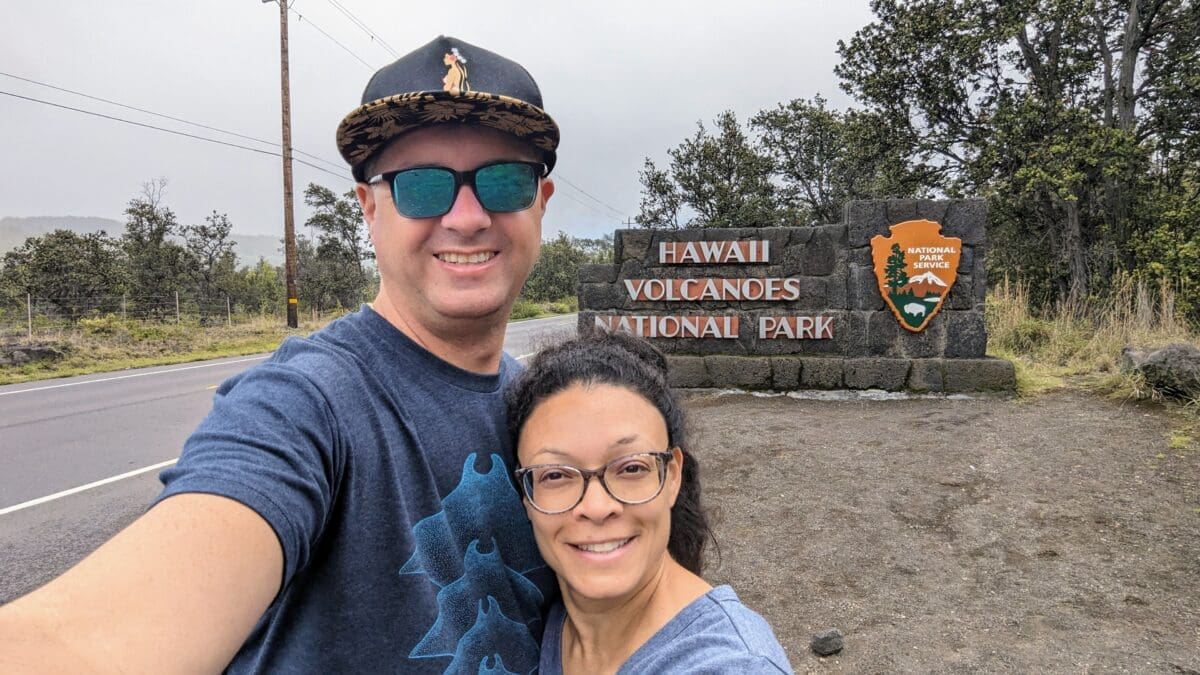Hawaiʻi Volcanoes National Park highlights nature’s raw power and the Big Island’s deep cultural roots. From Kīlauea’s smoking craters to vibrant rainforests, the park offers unforgettable sights for adventurers and culture lovers. In this blog post, we’ll share our journey and helpful tips to plan your visit.
A Deep Dive into Hawaiʻi Volcanoes National Park
Established in 1916, Hawaiʻi Volcanoes National Park spans over 335,000 acres, encompassing two of the world’s most active volcanoes: Kīlauea and Mauna Loa. Kīlauea, known for its frequent eruptions, has shaped the park’s dramatic landscape, with notable activity from 1983 to 2018 creating vast lava fields and craters like Halemaʻumaʻu, the legendary home of Pele, the Hawaiian goddess of fire and volcanoes. The park’s history is intertwined with Native Hawaiian culture, evidenced by petroglyphs, ancient foot trails, and preserved footprints from the 1790s caught in ashfall. It’s a UNESCO World Heritage Site, celebrated for its geological significance and biodiversity, hosting rare species like the nēnē (Hawaiian goose) and happyface spiders.
Within the park, the historic Volcano House hotel offers a cozy retreat with unparalleled views. Dating back to 1846 as a grass shack, it evolved into a charming lodge, rebuilt in 1941 after a fire. Today, it features 33 guest rooms, 10 cabins, and 16 campsites nestled among eucalyptus trees. Guests can dine at The Rim restaurant while overlooking Halemaʻumaʻu Crater, or relax on the balcony enjoying volcanic views. Staying here places you steps from Crater Rim Trail, making it a perfect base for exploration.
Practical Information for Your Visit

Hawaiʻi Volcanoes National Park is open 24 hours a day, 7 days a week, including holidays, allowing flexibility for sunrise hikes or nighttime crater glow viewing when active. The Welcome Center, located 1.2 miles past the entrance on Crater Rim Drive, operates daily with ranger-led programs and updates on park conditions. Note that the Kīlauea Visitor Center is under renovation until at least 2026, with temporary facilities at Kilauea Military Camp. Entrance fees are $30 per vehicle (15 passengers or less), $25 per motorcycle, or $15 per pedestrian/bicyclist for a 7-day pass. A Hawaiʻi Tri-park Annual Pass costs $55, covering Haleakalā and Puʻuhonua o Hōnaunau parks too. The Kahuku Unit, 70.5 miles south of Hilo, is open Thursday to Sunday, 8 a.m. to 4 p.m. Always check nps.gov/havo for alerts, as volcanic activity can close trails.
Our Unforgettable Experience
Our day at Hawaiʻi Volcanoes National Park was a thrilling blend of education and adventure. We kicked off with a guided ranger tour along the Crater Rim Trail, a scenic path circling Kīlauea’s summit caldera. Our ranger shared fascinating insights about Kīlauea’s eruptive history, pointing out how its 2018 collapse doubled Halemaʻumaʻu’s size. We learned about the nēnē, Hawaii’s endangered state bird, often spotted waddling near trails—drive carefully, as cars are their biggest threat! The ranger also wove in stories of Pele, whose fiery spirit is said to govern the volcano, creating a deep connection to Hawaiian folklore. For a guided tour, check the Welcome Center for daily schedules; they’re free and typically last 1–2 hours.

Next, we visited the Steam Vents along Crater Rim Drive, a short walk from the parking area. Standing over these rugged holes, we felt warm plumes of volcanic steam and caught the sharp, sulfurous scent of the earth’s inner workings. It’s a safe, quick stop, but stay on marked paths—nearby vents are gated for safety. The surrounding grassy fields, warmed by underground heat, contrast beautifully with the rainforest nearby.

The highlight was hiking the Kilauea Iki Trail, a 4.3-mile loop descending 948 feet into Kīlauea Iki Crater. Starting in a lush rainforest, the trail winds through towering ʻōhiʻa trees and ferns, alive with the calls of ʻapapane birds. As we navigated the switchbacks, the scenery shifted dramatically to a barren, moonlike expanse of cracked volcanic rock, the remnants of a 1959 lava lake. Walking across the crater floor, we marveled at steam rising from fissures and the sheer scale of Pele’s handiwork. The ascent back up is steep—counterclockwise is easier with switchbacks rather than steps.
Pro tips:
Bring at least 2 liters of water per person, as there’s no refill station. Wear sturdy hiking shoes; volcanic rock is razor-sharp, and a fall could mean cuts. Sunscreen and a hat are essential, as the crater floor offers no shade. Start before 9 a.m. to avoid the crowds and heat. Park at Kīlauea Iki Overlook if the Thurston Lava Tube lot is full. This hike is a bucket-list experience you can’t miss
Overall Impressions of Hawaiʻi Volcanoes National Park

Though we didn’t witness an active lava flow, Hawaiʻi Volcanoes National Park left us in awe of Pele’s legacy. The cracked lava fields held a stark beauty, with ʻōhiʻa lehua flowers pushing through the hardened destruction. Their resilience spoke to nature’s endless cycle of renewal, where life emerges even from the harshest landscapes. From cultural stories to jaw-dropping geology, the park is a testament to Hawaii’s untamed spirit. Ready to explore it yourself? Check out our YouTube channel for more travel inspiration. Or visit our Plan Your Trip page to start crafting your dream adventure!


Leave a Reply